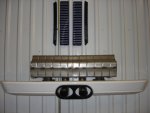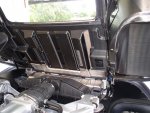Has anyone noticed how the underside of the clamshell that sits directly over the muffler can develop small cracks from the heat generated by the muffler. I have always been concerned about this area because it fits so very close to the muffler. The heat buildup there can be significant.
Engine heat affecting clamshell??
- Thread starter bob700
- Start date
You are using an out of date browser. It may not display this or other websites correctly.
You should upgrade or use an alternative browser.
You should upgrade or use an alternative browser.
BlackICE
GT Owner
Has anyone noticed how the underside of the clamshell that sits directly over the muffler can develop small cracks from the heat generated by the muffler. I have always been concerned about this area because it fits so very close to the muffler. The heat buildup there can be significant.
Wasn't a big concern to me. The brick OEM muffler was replaced within 1200 miles with a cat back system. My paint and plastic vents still look great. They were tested in the heat of TX during Rally 4!
DanQ
GT Owner
For those keeping the stock exhaust, I wonder if some heat reflecting foil might not be a good thing to add?
https://www.pegasusautoracing.com/productselection.asp?Product=1838
https://www.pegasusautoracing.com/productselection.asp?Product=1838
H
HHGT
Guest
Jan A. Byrd
GT Owner
For those keeping the stock exhaust, I wonder if some heat reflecting foil might not be a good thing to add?
https://www.pegasusautoracing.com/productselection.asp?Product=1838
That is what I had done. Some heat insulation material was applied across that area to protect the clamshell. Looks good and was not expensive. That area where the heat has the most effect on the clamshell is also the main support for the clamshell. I want to maintain that area's integrity.
That is what I had done. Some heat insulation material was applied across that area to protect the clamshell. Looks good and was not expensive. That area where the heat has the most effect on the clamshell is also the main support for the clamshell. I want to maintain that area's integrity.
It would be great if you posted some pics of your solution.:thumbsup
Here is a pic. Some of the color you see is the resin which in itself acts as a heat barrier also.
Thank you for the follow up pic. Did you use the same reflective film from Pegasus?
Thank you for the follow up pic. Did you use the same reflective film from Pegasus?
I do not think so.
MR2Race
FGT The Velvet Hammer
Do any of the aftermarket mufflers have any insulation material?
Or is the hot gas contained only by a single layer of metal?
(With no insulation material surounding the can portion of the muffler)
Or is the hot gas contained only by a single layer of metal?
(With no insulation material surounding the can portion of the muffler)
tmctguer
GT Owner
Bob700: Thanks for the picture.
I wonder if there is a benefit of putting reflective material over more surface area of the underside of the clamshell (longer lifespan of the clamshell, less long term damage to paint on clamshell,etc.)?
And the opposite -- would there be any detriment to covering more of the clamshell (reflecting too much heat back into the engine compartment, overheating the glass window, etc.)?
I wonder if there is a benefit of putting reflective material over more surface area of the underside of the clamshell (longer lifespan of the clamshell, less long term damage to paint on clamshell,etc.)?
And the opposite -- would there be any detriment to covering more of the clamshell (reflecting too much heat back into the engine compartment, overheating the glass window, etc.)?
MR2Race
FGT The Velvet Hammer
Anyone ever document what the under hood temps are?
Before and after a modification.
Some method to determine the amount of change?
Hot to the touch is too course an increment. .
Before and after a modification.
Some method to determine the amount of change?
Hot to the touch is too course an increment. .
tmctguer
GT Owner
I was thinking about doing my own temperature testing. I am trying to figure out how to get a temp probe inside the engine bay that can measure ambient temps.
The things I wanted to test were: A. The "license plate spacer" idea (which sounds good given the huge hole sitting behind the license plate), B. The "muffler cover" developed by a fellow board member who works with thermal material, C. Reflective material placed on the underside of the clamshell.
The key is to replicate testing conditions on each attempt (e.g. Outside temp, length of drive, similar RPM, similar starts/stops, etc). No easy feat but if I can find time to test, and conduct similar test runs, I will post results.
The things I wanted to test were: A. The "license plate spacer" idea (which sounds good given the huge hole sitting behind the license plate), B. The "muffler cover" developed by a fellow board member who works with thermal material, C. Reflective material placed on the underside of the clamshell.
The key is to replicate testing conditions on each attempt (e.g. Outside temp, length of drive, similar RPM, similar starts/stops, etc). No easy feat but if I can find time to test, and conduct similar test runs, I will post results.
MR2Race
FGT The Velvet Hammer
MAD in NC did this with an infrared measurement device years ago. Look for his old posts.
I hope it was not a hand held infrared meter.
MR2Race
FGT The Velvet Hammer
I was thinking about doing my own temperature testing. I am trying to figure out how to get a temp probe inside the engine bay that can measure ambient temps.
The things I wanted to test were: A. The "license plate spacer" idea (which sounds good given the huge hole sitting behind the license plate), B. The "muffler cover" developed by a fellow board member who works with thermal material, C. Reflective material placed on the underside of the clamshell.
The key is to replicate testing conditions on each attempt (e.g. Outside temp, length of drive, similar RPM, similar starts/stops, etc). No easy feat but if I can find time to test, and conduct similar test runs, I will post results.
I have a few low buck thermocouple readouts I have been using.
For real time measurements.
That along with K-type wire, fused on the end.
Becomes a fine thermocouple for under hood air temp.
As well as a method to measure a surface temp.
Also have a solution for data logging the data if required.



